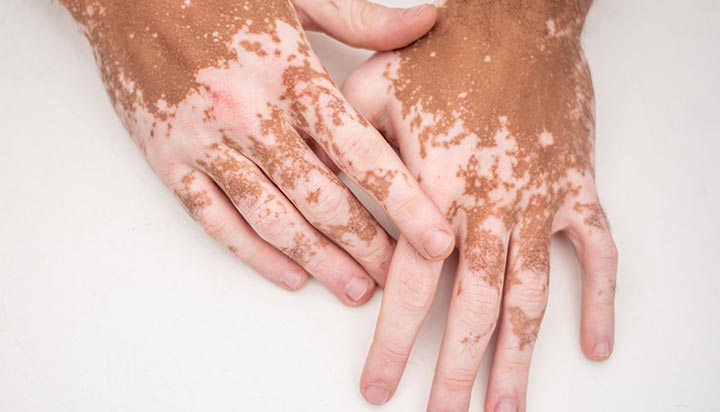Makindo Medical Notes"One small step for man, one large step for Makindo" |
|
|---|---|
| Download all this content in the Apps now Android App and Apple iPhone/Pad App | |
| MEDICAL DISCLAIMER: The contents are under continuing development and improvements and despite all efforts may contain errors of omission or fact. This is not to be used for the assessment, diagnosis, or management of patients. It should not be regarded as medical advice by healthcare workers or laypeople. It is for educational purposes only. Please adhere to your local protocols. Use the BNF for drug information. If you are unwell please seek urgent healthcare advice. If you do not accept this then please do not use the website. Makindo Ltd. |
Vitiligo
-
| About | Anaesthetics and Critical Care | Anatomy | Biochemistry | Cardiology | Clinical Cases | CompSci | Crib | Dermatology | Differentials | Drugs | ENT | Electrocardiogram | Embryology | Emergency Medicine | Endocrinology | Ethics | Foundation Doctors | Gastroenterology | General Information | General Practice | Genetics | Geriatric Medicine | Guidelines | Haematology | Hepatology | Immunology | Infectious Diseases | Infographic | Investigations | Lists | Microbiology | Miscellaneous | Nephrology | Neuroanatomy | Neurology | Nutrition | OSCE | Obstetrics Gynaecology | Oncology | Ophthalmology | Oral Medicine and Dentistry | Paediatrics | Palliative | Pathology | Pharmacology | Physiology | Procedures | Psychiatry | Radiology | Respiratory | Resuscitation | Rheumatology | Statistics and Research | Stroke | Surgery | Toxicology | Trauma and Orthopaedics | Twitter | Urology
Related Subjects: |Nikolsky's sign |Koebner phenomenon |Erythema Multiforme |Pyoderma gangrenosum |Erythema Nodosum |Dermatitis Herpetiformis |Lichen Planus |Acanthosis Nigricans |Acne Rosacea |Acne Vulgaris |Alopecia |Vitiligo |Urticaria |Basal Cell Carcinoma |Malignant Melanoma |Squamous Cell Carcinoma |Mycosis Fungoides (Sezary Syndrome) |Xeroderma pigmentosum |Bullous Pemphigoid |Pemphigus Vulgaris |Seborrheic Dermatitis |Pityriasis/Tinea versicolor infections |Pityriasis rosea |Scabies |Dermatomyositis |Toxic Epidermal Necrolysis |Stevens-Johnson Syndrome |Atopic Eczema/Atopic Dermatitis |Psoriasis
Vitiligo 🎨 may be part of the polyglandular autoimmune syndrome, alongside conditions like type 1 diabetes, autoimmune adrenal insufficiency, and autoimmune thyroid disease.
📖 About
- Characterised by acquired depigmented patches of skin due to melanocyte destruction.
- May be a benign finding in some individuals but has a strong association with autoimmune disease (15× increased risk).
- Onset is often in childhood or young adulthood, with a chronic and relapsing course.
- In rare cases, it can follow an autosomal dominant inheritance pattern.
🔬 Aetiology & Pathophysiology
- Autoimmune destruction of melanocytes by anti-melanocyte antibodies and autoreactive T-cells.
- Skin biopsy → absence of melanocytes in depigmented patches.
- Genetic predisposition + environmental triggers (stress, trauma, sunburn) play a role.
- Koebner phenomenon: new lesions appear at sites of trauma.
🤝 Associations
- Endocrine: Thyroid disease (Hashimoto’s, Graves’), Addison’s disease, diabetes mellitus, hypoparathyroidism.
- Haematological: Pernicious anaemia (B12 deficiency).
- Dermatological: Alopecia areata, psoriasis, lichen sclerosus.
- Ocular: Uveitis, retinal pigment changes.
- Often seen within autoimmune polyglandular syndromes.

👀 Clinical Features
- Well-demarcated, milky-white depigmented patches of skin.
- Symmetrical distribution common; often affects face, hands, elbows, knees, and genitalia.
- Hyperpigmented borders may surround depigmented patches.
- Hair within affected patches may also turn white/grey (leukotrichia).
- Lesions may become itchy or inflamed after sun exposure.
🧪 Investigations
- Primarily a clinical diagnosis.
- Blood tests for associated autoimmune disease:
- FBC & B12 → pernicious anaemia.
- TFTs → autoimmune thyroid disease.
- U&E & calcium → adrenal / parathyroid involvement.
- Autoantibody screen → thyroid, adrenal, parietal cell, IF antibodies.
- Wood’s lamp (UV light) examination → patches fluoresce bright white.
💊 Management
- Education & support: chronic condition, variable progression, no risk of skin cancer from vitiligo itself.
- Cosmetic camouflage (make-up, self-tan products) for psychological support.
- Topical corticosteroids or calcineurin inhibitors (e.g., tacrolimus) → early lesions.
- Phototherapy: Narrowband UVB or PUVA may induce repigmentation in some cases.
- Depigmentation therapy (monobenzone) may be considered for extensive disease (>50% body surface area).
- Counselling: high psychological impact; screen for depression, especially in adolescents.
- Regular monitoring for associated endocrine disorders.
🔮 Prognosis
- Unpredictable course: some patients stabilise, others show progressive spread.
- Repigmentation may occur spontaneously but is often incomplete.
- Chronic condition requiring long-term psychological and dermatological support.